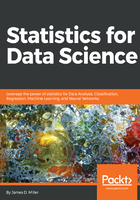
Visualizing
It is a common practice today to produce visualizations in a dashboard format that can show updated individual key performance indicators (KPI). Moreover, communicating a particular point or simplifying the complexities of mountains of data does not require the use of data visualization techniques, but in some ways, today's world may demand it.

Most would likely agree that scanning numerous worksheets, spreadsheets, or reports is mundane and tedious at best while looking at charts and graphs (such as a visualization) is typically much easier on the eyes. To that point, both the data developer and the data scientist will equally be found designing, creating, and using data visualizations. The difference will be found in the types of visualizations being created. Data developers usually focus on the visualization of repetitive data points (forecast versus actuals, to name a common example), while data scientists use visualizations to make a point as part of a statistical project.
Again, a data developer most likely will leverage visualizations to illustrate or highlight, for example, sales volumes, month-to-month for the year, while a data scientist may use visualizations to predict potential sales volumes, month-to-month for next year, given seasonality (and other) statistics.